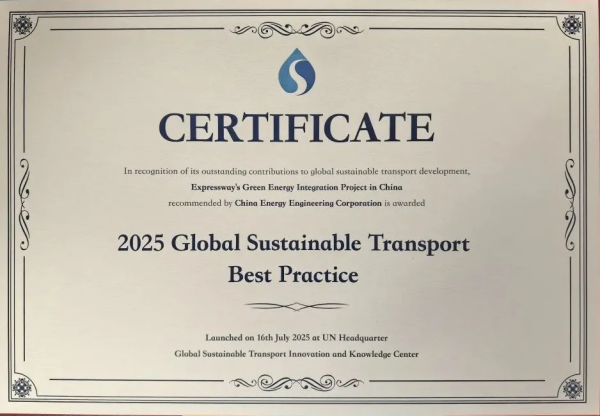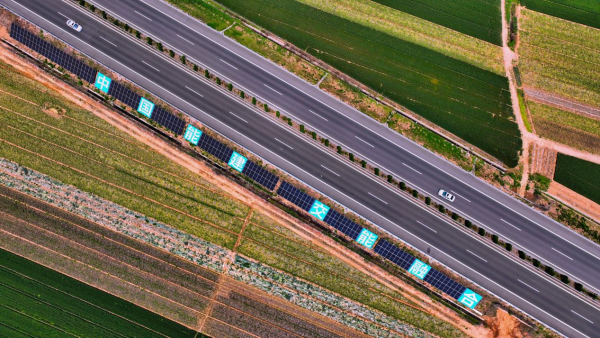The United Nations has officially announced its list of 2025 Global Sustainable Transport Best Practices, with China’s Zaozhuang-Heze Expressway Transportation and Energy Integration Demonstration Project standing out among them.This innovative project is developed by China Energy Engineering Group Co., Ltd. (Energy China).

Certificate of 2025 Global Sustainable Transport Best Practice [Photo/sasac.gov.cn]
Listed alongside global benchmarks such as the UN ESCAP’s electric mobility transition in public transport, Brazil’s transport resilience program, and Singapore’s zero-carbon port, the project highlights China’s innovation in sustainable transport.
A Chinese solution: Redefining transportation and energy integration
As China’s first expressway transportation and energy integration project, it uses suitable slopes along the expressway and rooftops or ground space within service areas and toll stations to install a 124-megawatt distributed photovoltaic system.

A view of the slope photovoltaic power project along the Zaozhuang-Heze Expressway [Photo/sasac.gov.cn]
A series of innovative systems including a zero-carbon smart service area, buildings equipped with flexible direct-current photovoltaic-storage systems, and an integrated traffic-energy management platform were also built. These efforts enable systematic planning, joint construction, and integrated operation of energy use, supply, and distribution — turning green electricity into intelligent, economical, and eco-friendly transport power, and advancing the high-quality green development of the transport sector.
A green revolution with real impact
With the completion and commissioning of both Phase I and II, totaling 78 MW, the project now stands as the largest single expressway-based transportation and energy integration initiative in China in terms of installed capacity.
To date, it has generated 83.17 million kWh of clean electricity, easing peak summer demand in the region and lowering energy costs along the expressway and surrounding areas. It has saved approximately 24,500 tons of standard coal, reduced carbon dioxide emissions by 37,400 tons, and issued 83,171 Green Power Certificates.
Setting standards: Chinese technology in transportation and energy integration
The project was designed from a full life-cycle perspective, covering planning, design, construction, operation, and maintenance. It continuously explores cutting-edge demonstration technologies, leading to the publication of China’s first “Expressway and Energy Integration Standard System.” It also led to the development of five key technical standards for such projects, including photovoltaic design for highways, construction and light-impact assessment, safety evaluation, and operation & maintenance protocols.
Together, they fill a domestic gap in safety and environmental evaluation, construction, and O&M standards for integrated expressways, offering a replicable model to the world in sustainable transportation and energy integration.
The project has received the UN PPP and Infrastructure Award, the only recipient from China. It has also been recognized by the National Energy Administration as a typical case in green and low-carbon energy transition, approved as China’s first national demonstration base for transportation and energy integration, and supported by the Ministry of Transport as a pilot for building China into a transportation powerhouse.
Beyond expressways, Energy China is applying its integrated transportation and energy model to green ports, waterways, airports, and rail transit. The company continues to provide end-to-end green solutions to drive sustainable and high-quality development across the transport sector.
(Executive editor: Yuan Ting)